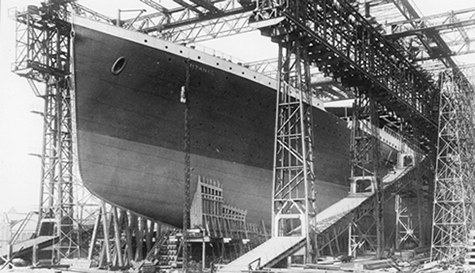Titanic's Launch
Wednesday 31st May 1911, was an exciting day in Belfast. Having successfully completed her sea trials, Olympic, Titanic's near identical sister ship, left Belfast for the first time, ready to begin her maiden voyage; while, earlier in the day, Titanic, her hull now largely completed, had been launched into the water from slipway number 3, at Harland and Wolff shipyard, watched by an estimated 100,000 onlookers.
Amongst the crowds, on a specially constructed grandstand, were John Pierpont Morgan, who had headed the formation of the shipping combine, known as the International Mercantile Marine Company (IMM), which owned Titanic's owner and operator, the White Star Line; Joseph Bruce Ismay, the Managing Director of both IMM and White Star Line, who would go on to become a notable Titanic survivor; the Lord Mayor of Belfast, and other important people, including representatives of White Star Line and Harland and Wolff.
Another grand stand had been provided for members of the press, many of which had travelled across the Irish sea on a specially charted steamer, the Duke of Argyll. A further two grand stands were provided for other ticket holders.

Titanic under construction.
Those who did not have a place on the grandstands took advantage of any other vantage point to view the launch, including at the Albert Quay, where the Belfast Harbour Commissioners, had fenced off an area with a good view, so that they could sell tickets for a shilling to raise money for local hospitals. Most of Harland and Wollf's workers are said to have had the day off so that they could watch the special occasion. The weather on the day was noted as being good.
On the morning of the launch, Harland and Wolff workers had been busy preparing the ship for launching, including removing timber supports holding the ship in place; Harland and Wolff's chairman, Lord William James Pirrie - who on the day was celebrating his 64th birthday - had the honour of superintending the launch.
Shortly after 12pm red rockets were started to be fired warning people that the launching was imminent. Following a last-minute conversation with the foreman in charge of the launching, Lord Pirrie, reported in the newspapers as having been wearing a blue suit and a yachting cap, gave the order for the last supports holding Titanic in place to be removed, starting the ship's journey into the water at 12.13pm.
Under her own weight, with the help of over 20 tons of tallow, soap and train oil, Titanic slid down the slipway within 62 seconds, reaching a maximum speed of 12 knots. Once fully in the water, floating for the very first time, Titanic was stopped by six special anchor chains and two piles of cable drag chains, weighing 80 tons each. The launch had been a success.

Titanic being launched on 31st May 1911.
After the launching was complete, Titanic was towed by tug boats to her new berth, ready for the next stage of her construction to begin, which included the finishing of her exterior, installation of machinery, and fitting of her interiors, including her luxury first class accommodation. Up to this point Titanic had been under construction for just over two years, and would be fully completed in just under a year's time.
Many of the invited guests were afterwards treated to lunch in Belfast. With John Pierpont Morgan, Joseph Bruce Ismay, Lord Pirrie and a number of other representatives of White Star Line and Harland and Wolff aboard Olympic set sail later in the afternoon for Liverpool, for a quick visit before heading to Southampton ready for her maiden voyage.
Not much under a year later, on 2nd April 1912, Titanic would go on to have her sea trial undertaken, and to then depart Belfast and sail to Southampton for her first time. Olympic's successful career would be very different to her sister Titanic's career with White Star Line.
Related pages - Titanic's Sea Trials, All Titanic Pages